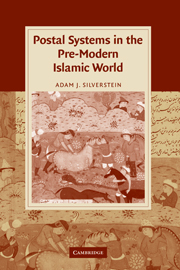Book contents
- Frontmatter
- Contents
- List of maps
- Acknowledgements
- List of abbreviations
- Introduction
- PART I THE PRE-ISLAMIC BACKGROUND
- PART II CONQUEST AND CENTRALISATION – THE ARABS
- 2 al-Barīd: the early Islamic postal system
- 3 Dīwān al-Barīd: the Middle Abbasid period
- PART III CONQUEST AND CENTRALISATION – THE MONGOLS
- Conclusions
- Appendix: distances and speeds of the Barīd
- Bibliography
- Index
- Cambridge Studies in Islamic Civilization
2 - al-Barīd: the early Islamic postal system
Published online by Cambridge University Press: 18 July 2009
- Frontmatter
- Contents
- List of maps
- Acknowledgements
- List of abbreviations
- Introduction
- PART I THE PRE-ISLAMIC BACKGROUND
- PART II CONQUEST AND CENTRALISATION – THE ARABS
- 2 al-Barīd: the early Islamic postal system
- 3 Dīwān al-Barīd: the Middle Abbasid period
- PART III CONQUEST AND CENTRALISATION – THE MONGOLS
- Conclusions
- Appendix: distances and speeds of the Barīd
- Bibliography
- Index
- Cambridge Studies in Islamic Civilization
Summary
Introduction
By the mid ninth century the Barīd consisted of a well-coordinated network of routes, stations, postal chiefs, and a postmaster-general, all of which were paid for by the caliph's resources. Between the adoption of a rudimentary courier-service during the conquests and the high-point of the postal system's organisation in the ninth century, the Barīd underwent a developmental process the major stages of which will be described and analysed below.
In some ways ʿUmarī (1301–49) has facilitated our task by describing the evolution of the Barīd in a straightforward, sequential account. In his words:
The first person to establish the Barīd in Islam was Muʿāwiya ibn Abī Sufyān … He established the Barīd to expedite the arrival of intelligence (akhbār) to him from his outlying provinces. He therefore ordered that Persian dihqāns and people of the Byzantine provinces be brought before him, and he explained to them what it is that he wanted, and they established the burud, using mules with pack-saddles as the means of transportation. Some, however, say that this happened during the reign of ʿAbd al-Malik ibn Marwān, when he rid himself of the Kharijites … [The caliph] al-Walīd ibn ʿAbd al-Malik used [the Barīd] to transport mosaics – which is gilded tesserae – from Constantinople to Damascus … The Barīd remained in existence and in constant use until the time came for the collapse of the Marwanid state, and the unravelling of Marwanid power. The Marwanids were cut off from [all the land] between Iraq and Khurasan, since the notables turned to the Shiʿism that upheld the Abbasid state. […]
- Type
- Chapter
- Information
- Postal Systems in the Pre-Modern Islamic World , pp. 53 - 89Publisher: Cambridge University PressPrint publication year: 2007



